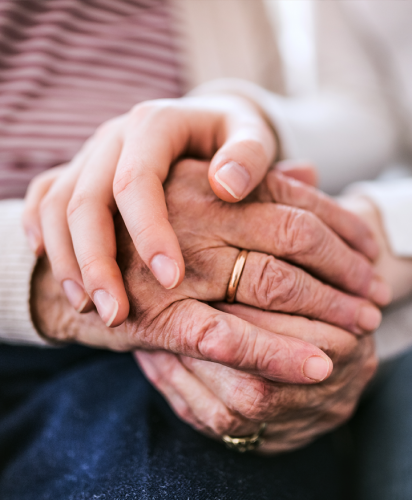
Summary
Early palliative care involves combining palliative support with standard cancer care shortly after a patient is diagnosed with incurable and/or advanced cancer. Compared with standard cancer care alone, early palliative care improves quality of life, survival, clinical outcomes, mood and healthcare satisfaction in patients with advanced cancers.1-4 It may also be less costly than standard care for advanced cancers.5 There is also a positive effect on carers, who report lower levels of psychological distress and depression than carers of patients in standard cancer care.6
Challenge
The World Health Organization (WHO) defines palliative care as a healthcare approach that improves the quality of life of patients and families facing life-threatening illness through the treatment of pain and other physical, psychosocial and spiritual problems.7 While palliative care for cancer is traditionally introduced late in the disease course, earlier introduction of palliative care may help patients with incurable cancers manage their symptoms and quality of life. This may be the case for patients with metastatic non-small-cell lung cancer (NSCLC), who often die within one year of diagnosis.2 8
Solution
A trial at the Massachusetts General Hospital in Boston introduced early palliative care for patients with metastatic NSCLC – patients began their treatment with a palliative care physician or nurse within 12 weeks of their diagnosis. The study compared a combination of standard cancer care and early palliative care with standard cancer care alone, looking at differences in patients’ healthcare use, quality of life, mood and survival.2
What did it achieve?
Results of early palliative care for metastatic NSCLC
The randomised controlled trial at the Massachusetts General Hospital enrolled 151 patients, with 107 patients completing the 12-week follow-up (47 patients in standard cancer care and 60 patients in early palliative care).
Early palliative care showed positive improvements compared with standard cancer care alone, and patients’ health-related quality of life was significantly higher:2
| Early palliative care | Standard cancer care | |||
| Median survival | 11.6 months | 8.9 months | ||
| Percentage of patients with depression | 16% | 38% | ||
| Percentage of patients admitted to hospice (last 3 days of life) | 3% | 15% | ||
| Percentage of patients visiting emergency department (last 30 days of life) | 22% | 30% | ||
| Percentage of patients admitted to hospital (last 30 days of life) | 37% | 54% |
Another study with metastatic NSCLC patients in China found that early palliative care significantly improved patients’ quality of life, mood and lung function when compared with standard cancer care alone.9
Results of early palliative care for other advanced cancers
For patients with incurable lung cancer (not limited to metastatic NSCLC), early palliative care resulted in:
- higher quality of life, compared with standard cancer care alone
- lower rates of depression, compared with standard cancer care alone.1
Compared with late palliative care for patients with incurable advanced cancer, early palliative care offered more positive outcomes:3
| Early palliative care | Late palliative care | |||
| Healthcare costs, per patient | $32,095 | $37,293 | ||
| Percentage of patients admitted to hospital (last 30 days of life) | 33% | 66% | ||
| Percentage of patients visiting emergency department (last 30 days of life) | 34% | 54% | ||
| Percentage of patients who died within 30 days of hospital admission | 33% | 66% | ||
| Percentage of patients who died within 3 days of hospital discharge | 16% | 39% |
In patients with advanced cancers (lung, gastrointestinal, breast or gynaecological), early palliative care produced:
- higher quality of life, compared with standard cancer care alone
- higher satisfaction with care, compared with standard cancer care alone.4
Compared with carers of advanced lung and gastrointestinal cancer patients in standard cancer care, carers of patients in early palliative care reported:
- significantly lower levels of psychological distress
- significantly lower levels of depression.6
Further information
- A literature review on the cost and cost-effectiveness of palliative care
- A Cochrane review on early palliative care for adults with advanced cancer
- The American Society of Clinical Oncology statement supporting early palliative care for patients with advanced cancer
References:
- Temel JS, Greer JA, El-Jawahri A, et al. 2017. Effects of early integrated palliative care in patients with lung and GI cancer: a randomized clinical trial. J Clin Oncol 35(8): 834-41
- Temel JS, Greer JA, Muzikansky A, et al. 2010. Early palliative care for patients with metastatic non-small-cell lung cancer. N Engl J Med 363(8): 733-42
- Scibetta C, Kerr K, McGuire J, et al. 2016. The costs of waiting: implicaitons of the timing of palliative care consultations among a cohort of decedents at a comprehensive cancer centre. J Palliat Med 19(1): 69-75
- Zimmermann C, Swami N, Krzyzanowska M, et al. 2014. Early palliative care for patients with advanced cancer: a cluster-randomised controlled trial. Lancet 383(9930): 1721-30
- Smith S, Brick A, O'Hara S, et al. 2014. Evidence on the cost and cost-effectiveness of palliative care: a literature review. Palliat Med 28(2): 130-50
- El-Jawahri A, Greer JA, Pirl WF, et al. 2017. Effects of early integrated palliative care on caregivers of patients with lung and gastrointestinal cancer: a randomised clinical trial. Oncologist 22(12): 1528-34
- World Health Organization. WHO Definition of Palliative Care. Available here: https://www.who.int/cancer/palliative/definition/en/ [accessed: March 2019]
- Jemal A, Siegel R, Ward E, et al. 2009. Cancer statistics, 2009. CA Cancer J Clin 59(4): 225-49
- Zhuang H, Ma Y, Wang L, et al. 2018. Effect of early palliative care on quality of life in patients with non-small-cell lung cancer. Curr Oncol 25(1): e54-e58